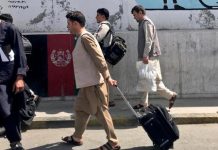
YOU WOULD bet on any screenshot of Singaram village to clinch a picture postcard contest. There is a surfeit of National Geographic moments here. As the sun warms up behind the thick forested hills, sinewy village acrobats glide up the toddy trees to tap their day’s white poison; someone hurries to the monthly cockfight 12km south, a throaty fat bird with an angry frown pinched tight in his underarms; the tireless granny shifts cots about and noisily sweeps her mud hut’s porch. Teenagers here guess their ages by when they broke their moustache or began menstruating. Older, they forget even that. Asked for a past event’s time, people wave at the sky to show where the sun had been that moment. As night falls, a hushed darkness cloaks the village, which has never known electricity. Embers of firewood glowing in faraway huts round off the idyllic picture. For backpacking trekkers ever on the lookout for an off-the-beaten track, this should be it.
It isn’t. Singaram’s tragedy lies in the ruins of its school that no one has entered in years, in the abject terror of forest officials who turned their backs on its development a decade ago, in the roads destroyed by the raging Maoist insurgents, the Naxals, to stop the “others” from coming in ever. It seems utterly unbelievable on a visit, but the singular truth about Singaram and hundreds of such villages across thousands of square kilometres in south Chhattisgarh is the overwhelming and brutal violence that rules them, matching some of the worst militia-ravaged parts of the world such as in Colombia, Sudan and Iraq.
If anything, this is CNN country twentyfour seven, not that India’s news organisations are much interested in the rural violence here. Locals say heavily armed Naxal women and men boldly roam the region in battle fatigue and freely swoop on villages for nightly rests and daytime meals, but especially for their signature monthly meetings. They levy taxes on trades such as on the tendu plant leaves used for rolling bidis. They also kill “traitors” — anyone they think is a police informer or an ideological opponent, or the worst: a double agent — often by beating them for hours and slashing their throats in full view not just of hundreds of villagers but even the dying woman’s or man’s spouse, children and parents.
[box]
A GRIM REALITY
SP Rahul Sharma claims Naxals hold 40 percent of Dantewada and are fighting bitterly to seize another 20 percent
Government estimates admit Naxal ranks have swelled 20 times since the Salwa Judum was raised in 2005
In 2007, Naxals freed 300 from a prison. They also killed 52 policemen and 30 SPOs that year
Activist Himanshu Kumar says Naxals control three-fourths of 1,350 villages here
[/box]
THE NAXALS control 40 percent of Dantewada, basically its remote areas,” says Rahul Sharma, Superintendent of Police (SP) of this district in south Chhattisgarh. “The government controls a similar size. Both are fighting on the rest 20 percent.” Human rights activist Himanshu Kumar, who runs the NGO Vanvasi Chetna Ashram in Dantewada’s villages, laughs at Sharma’s figures. “The Naxals control everything except the few towns in this region,” says Kumar, whose organisation helps those it believes are innocent victims of police brutalities or are falsely accused as Naxals. To be precise, says Kumar, the Naxals control three-quarters of the 1,350 villages in Dantewada and the adjacent Bijapur district, which was carved out of the larger Dantewada in August 2008.

Both Sharma and Kumar, however, agree that violence is bound to shoot up dramatically in the region following the January 8, 2009 killings of 19 villagers, who the police say were Naxals, near Singaram village. Even as the Naxals called on the tribal people to observe a ‘Black Day’ on January 26, India’s Republic Day, police shot and killed five more men in the Bijapur district the previous day, claiming they were Naxals who fired the first shots in their “encounter”. Predictably, local villagers alleged that the police were lying and had, in truth, dragged the five unarmed men from their homes and shot them point blank. Kumar told TEHELKA he has sent out activists to investigate.
The renewed violence from the state seems the second stage of a strategy of offense launched in 2005, when police began burning down random villages to rob the Naxals of their support, their rations and hiding areas. (Police claim it was the Naxals who burned the villages, forcing the displaced villagers towards them.) The police moved these displaced villagers to hastily erected hutment collectives along the state highways, 20-odd of which are in operation in Dantewada and Bijapur, reportedly housing between 30,000 and 50,000 people. Able-bodied men and women among them were recruited as Special Police Officers (SPOs) to take on the Naxals, and kitted up with arms and uniforms. Today, some 1,200 of such young women and men, many of them, in fact, seemingly still in their teens, are each paid Rs 2,150 a month and used as frontline boots on the ground.

Now, as part of the second phase of the strategy, an elite group from among these SPOs is being trained in more critical counterinsurgency operations at a jungle warfare school in the town of Kanker, 250km north of Dantewada. The SPOs that participated in the January 8 raid near Singaram were trained here. They are now part of what is called a Special Task Force (STF) and report directly to Dantewada SP Sharma. The team has reportedly also trained in Jammu & Kashmir with an Indian Army unit. According to Soyam Muka, a former schoolteacher who heads seven Salwa Judum camps in Dantewada, these men have fully moved out of the camps and report directly to Sharma. Sharma told TEHELKA the unit would now get more aggressive in a bid to “flush out” the Naxals.
This elite team that led the January 8 attacks was equipped with two AK47s, a 7.62 LMG and 35 INSAS guns, which are infantry weapons in the Indian Army. Sharma also has a helicopter on demand, which was used to evacuate three SPOs who were allegedly injured on January 8. After Union Home Minister P Chidambaram’s visit to the state capital Raipur in the third week of January, Chhattisgarh Home Minister Nanki Ram Kanwar told TEHELKA the Centre had virtually offered unlimited funds and training for the counterinsurgency operations. Sharma believes this will translate into better weaponry for the SPOs.

For activist Kumar, none of this bodes well. “The Salwa Judum’s earlier attacks created terror in hundreds of villages,” he says. “Thousands of boys and girls have since picked up arms and are now roaming with the Naxals.” Kumar claims Salwa Judum attacks have killed more than 5,000 people. Last year, the state government admitted that the ranks of the Naxals may have increased more than 20 times since the Salwa Judum was raised. Over two years ago, in 2006, Naxals daringly attacked a Salwa Judum camp and killed 34 people.

A staunch supporter of the police action against Naxals, Muka, president of the seven Salwa Judum camps in Dantewada, however, knows the limitation of tit-for-tat against the Naxals, entrenched for decades. “Tribal brothers are dying on both sides,” Muka told TEHELKA at his residence in the small town of Konta, 170km south of Dantewada. “Ultimately, we must push for dialogue as that alone will bring lasting peace.”












